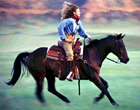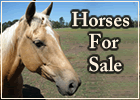

Developing the Solid Stop
A smooth, graceful, square halt is developed from excellent backing via the cue of small upward backward circles with both hands together lifting into the corners of the horse’s mouth (never pulling back!). The better and lighter a horse backs, the better will be your downward transitions and halts.
Correct backing results in a definite sequence of phases being: A. relaxing the jaw, B. lifting the neck (which shifts the weight off the forehand and moves it to the hindquarter), C. filling and rounding the back, D. tilting the pelvis, E. lowering the croup, F. flexing the hocks and G. bringing the back legs forward underneath the horse which all results in the collected frame.
With a horse in a forward motion, if the rider wants a good halt and begins to ask for backing then, naturally, the horse must slow down and stop before it can back up. If the stop is what you want then cease the cue as soon as the horse stops. Of course, in every movement, before any physical cue is initiated, the first and most important signal comes from your focused concentration, visualizing the successful completion of your desire. This strong thought creates an internal intent or energy that is definitely felt by the horse. What you are thinking and feeling on the inside is then displayed outwardly through your body language of a deeper seat with pelvis tilted back and an exhale of energy release thus you have stopped first in your mind and body and you can fully expect the horse, as a good dance partner, to follow your body and stop also.
In stopping from the backing cue, the horse will quickly go through the aforementioned phases A. – G. above thus stopping correctly on the haunches by “sitting down” into the stop rather than stopping heavy on the forehand, jamming the front legs into the ground.
Preventing the horse from curling his head behind the vertical is accomplished by the lifting action of the hands which keeps the face at or slightly in front of the vertical. See the below photo of Francois de la Gueriniere’s horse displaying the classically correct collected frame resulting from the lifting hands cue as developed by la Gueriniere for which he coined the phrase “demi-arret”, translated as “half halt”.
The graceful and square downward transitions and halts with an elevated forehand and lowered haunch are worthy goals for your schooling sessions and excellent reasons to add a good quantity of backing to your training regimen.
Enjoy the Journey,

Ed Dabney is an internationally acclaimed clinician, presenting horsemanship and riding clinics all over the US and in Europe. In 2007, Ed was named Champion of the East Coast Trainer Challenge Series by Equine Extravaganza. Ed was honored to have been selected by the University of Georgia to teach their senior level Young Horse Training course.
His training articles have appeared in many major national magazines. Ed produces instructional videos and the “Gentle Horsemanship” TV program which has been seen on RFD-TV.
Ed's blending of natural horsemanship and classical equitation has made an indelible mark with students all across the United States and now also in Europe, drawing the attention of serious riders searching for the lightest touch and the deepest connection with their horses irrespective of breed or discipline.


